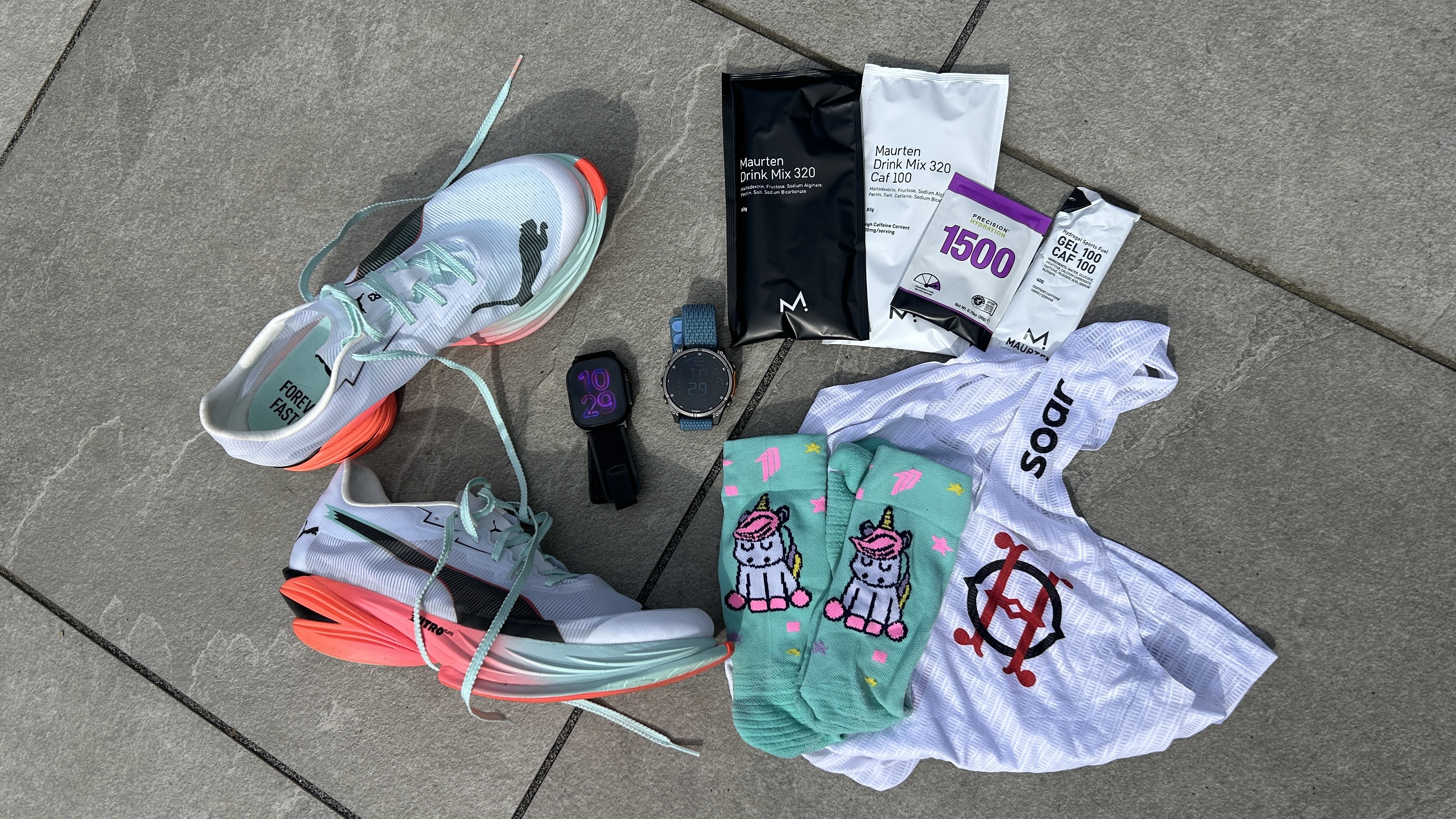8 Ways Snapdragon 855 Will Change Your Next Phone
The latest Snapdragon mobile processor introduces a lot of big changes to the mobile scene. Here are the big features Qualcomm added to the Snapdragon 855.
Editors' Note: Updated at 10 p.m. ET with additional details about the Snapdragon 855 throughout the story.
WAILEA, Hawaii — Every generation of mobile processor brings a slew of expected improvements — It's faster than ever! It consumes less power than before! — and you can certainly expect those kind of gains from Qualcomm's new Snapdragon 855 chipset.
But the latest mobile processor previewed here today (Dec. 5) by Qualcomm promises enough other notable improvements to mean big changes for your next smartphone.

Besides improvements to speed and efficiency — helped along by the fact that this is Qualcomm's first 7-nanometer chip — the Snapdragon 855 will allow phones to take advantage of the faster networking speeds available from next-generation 5G wireless networks. A new sensor in the chipset will enable phone makers to embed fingerprint readers underneath their devices' displays. And Qualcomm is talking up a host of other improvements, from a more sophisticated image signal processor that will boost smartphone cameras to a faster AI engine.
Qualcomm says that its partners are already sampling the Snapdragon 855. Look for the new mobile processing platform to start appearing in leading Android flagship devices during the first half of 2019, with OnePlus saying that its next flagship phone will be the among the first to be powered by the Snapdragon 855. (Update 12/6: Initial reports had OnePlus claiming that its phone would be the first to ship with Snapdragon 855, but OnePlus later clarified that was a misunderstanding based on an incorrect translation of CEO Pete Lau's announcement.)
When the chipset does start popping up in phones, here's what you can expect the Snapdragon 855 to deliver.
7-nanometer CPU: 45 percent performance boost
Sign up to get the BEST of Tom's Guide direct to your inbox.
Get instant access to breaking news, the hottest reviews, great deals and helpful tips.
Like the Kirin 980 and Apple A12 Bionic, Qualcomm is building the Snapdragon 855 using a 7-nanometer process. Other chips switching to the smaller design have seen a boost to power efficiency, and Qualcomm's latest is no exception.
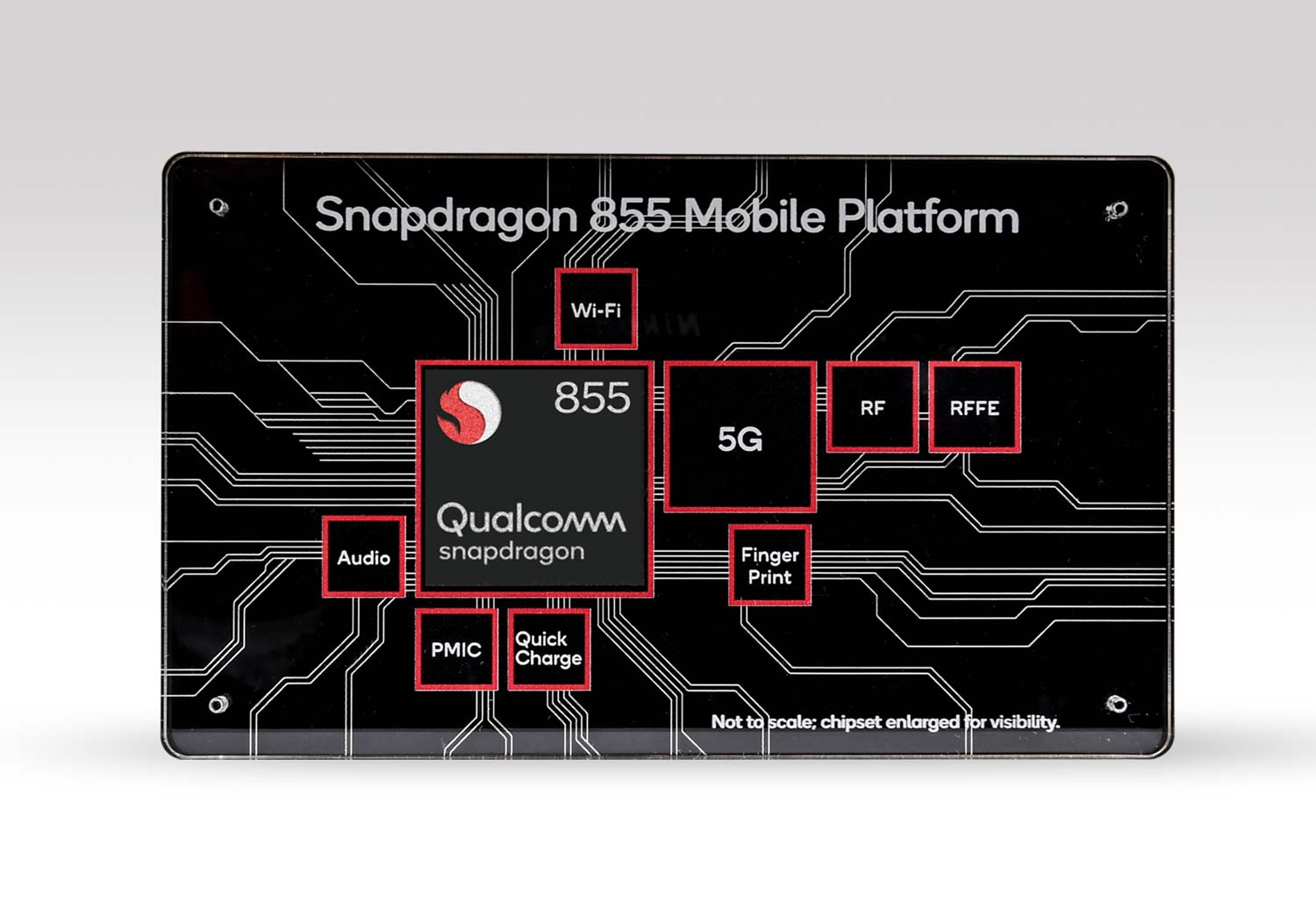
Qualcomm says the Kryo 485 CPU on the Snapdragon 855 processor delivers up to a 45 percent improvement over the performance found in the Snapdragon 845 that's powering leading Android flagship phones these days. Similarly, the Adreno 640 GPU on the new chipset can boost graphics performance by up to 20 percent over Qualcomm's current offering. That's the biggest performance increase ever for a Snapdragon update, Qualcomm senior director of product marketing Travis Lanier told Snapdragon Tech Summit attendees.
Left unsaid by Qualcomm is how these performance gains will help the latest Snapdragon close the gap with Apple's pace-setting CPU. The A12 Bionic is the fastest processor we've tested, turning in a score of 11,515 for the iPhone XS Max on the Geekbench 4 general performance benchmark. That's well ahead of the 9,014 turned in by the HTC U12+, the fastest performing 845-powered phone in our testing, and even with the promised improvement delivered by the Snapdragon 855, it seems like the iPhone could continue to enjoy its edge in speed.

Qualcomm did suggest that its new processor will boost performance in the apps mobile users turn to the most. A chart shown off by Lanier displayed apps including Gmail, Google Maps, Facebook, Twitter and YouTube all enjoying faster launch times on Snapdragon 855 than on other rival 7-nanometer processors (which would be the A12 Bionic and the Kirin 980). Another graphic appearing during the Snapdragon 855 unveiling touted sustained gaming performance — the Snapdragon 855 maintains a steady performance over time while other processors start to flag after an initial surge.
To that end, Snapdragon-powered phones have fared better in graphics testing, and the 855 figures to continue that trend. In addition to the better-performing GPU on the Snapdragon 855, the new chipset supports Vulkan 1.1 — a first on mobile — high dynamic range, and physically based rendering. All three of those features should contribute to more realistic gaming, according to Qualcomm, as part of the company's Elite Gaming initiative (which we'll talk about more in a little bit).
A demo after the Snapdragon 855's unveiling demonstrated the kind of power savings you can expect from the new mobile processor. Qualcomm set up two references devices with 3,000 mAh batteries side by side — one running the Snapdragon 845 and the other with the 855. Playing PUBG Mobile, the 855-powered device had an expected battery life that was more than an hour longer than the 845 device; the gap widened to about an hour and 15 minutes when performing on Instagram. In other words, expect longer battery life from phones running on a Snapdragon 855.
5G Support: Up to 20x faster speeds
The Snapdragon 855 will be ready for 5G even if it takes phone makers and especially cellular networks a little bit to catch up. The new mobile processor includes Qualcomm's X50 modem, the 5G-capable modem the company unveiled earlier this year.
The X50 can use both Sub-6 GHz and millimeter-wave (mmWave) frequency bands for 5G connectivity, which should allow phones equipped with the Snapdragon 855 to reach some eye-popping data speeds when connected to 5G networks. According to Qualcomm, for example, mmWave frequency bands can deliver a 20x boost to average performance compared to what's out there now.
MORE: The Truth About 5G: What's Coming (and What's Not) in 2019
Translation? You'll be able to perform data-intensive tasks — downloading 4K movies, transferring large files and streaming graphically intensive games with real-time responsiveness — that were either too much of a headache to perform on smartphones or not even feasible with today's cellular networks.
Of course, to reap those benefits, wireless carriers will have to launch their 5G networks, something that's not anticipated until later on in 2019. To ensure that flagship phones can still deliver fast data while 5G networks are rolling out, Qualcomm is also equipping the Snapdragon 855 with the X24 LTE modem. That's a Cat-20 modem capable of delivering 2 Gbps speeds, at least on LTE networks capable of supporting that kind of throughput.
Now that we have a mobile processing platform capable of powering 5G-capable phones, some of the burden is going to shift to phone makers to start producing these devices. Already this week, Samsung announced plans with both Verizon and AT&T to come out with 5G phones in early 2019, while LG and Sprint made similar promises back in August. Reports suggest that Apple will wait until 2020 to come out with a 5G iPhone, giving Qualcomm and the Android phone makers that use its Snapdragon platform a potential edge over their rival from Cupertino.
3D Sonic Sensor: Fingerprint reader under the display
With bezels around smartphone displays getting thinner, phone makers have been forced to find a new home for the fingerprint sensor. Generally, that's been on the back of the phone, which isn't always a convenient place to put it. A new sensor on the Snapdragon 855 will allow that sensor to remain on the front of the phone, where it will live under the display.
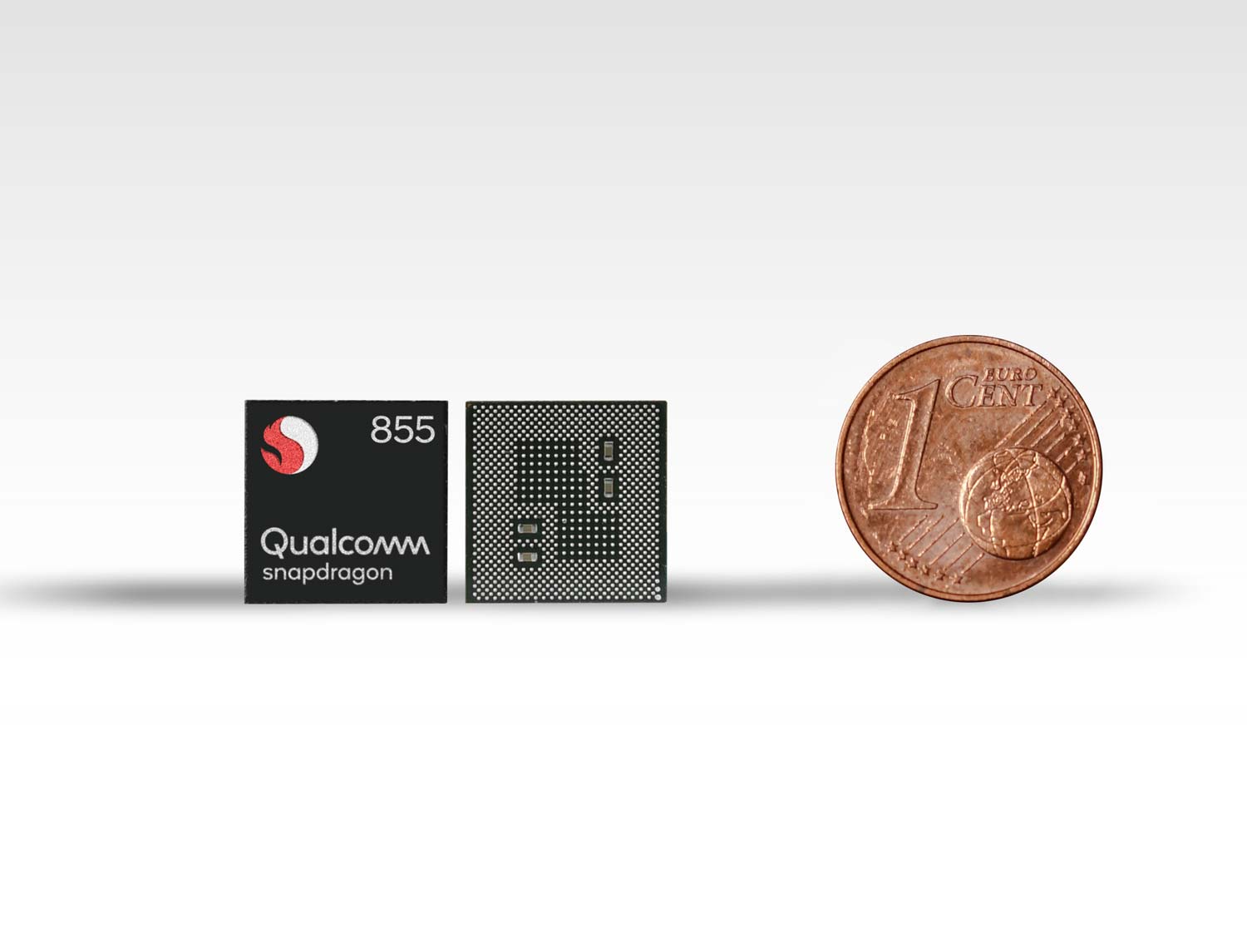
The Qualcomm 3D Sonic Sensor is an ultrasonic sensor that's different from capacitive sensors that are popular on older smartphones. For starters, Qualcomm says its sensor will be able to work even when your finger is wet, something other smartphones can't claim.
The OnePlus 6T already features an optical in-display sensor that works fairly quickly and reliably in our testing. We're eager to see how Qualcomm's 3D Sonic Sensor compares, especially with no demos of the new feature available here in Hawaii. (One Qualcomm rep told us that a preview might be in the offing at the Consumer Electronics Show in Las Vegas next month.) One thing that is for sure, though — with this feature now part of the Snapdragon 855 platform, look for a lot more devices to adopt embedded fingerprint sensors into their designs in 2019.
Spectra 380 ISP: Big camera upgrade
Cameras are one of the most critical features on a smartphone these days, and Qualcomm wants to make sure that the cameras on Snapdragon 855-powered handsets have some added oomph. The new chipset includes an improved Spectra 380 image signal processor (ISP) that boasts computer vision features capable of powering computation photography. Because those features are now built directly into the ISP instead of offloading them to the Snapdragon's Hexagon digital signal processor, you can expect a camera that will perform computational tasks more quickly. Object detection, for example will be 11 times faster thanks to the hardware enhancements made to the Spectra ISP, Qualcomm's Judd Heape told me.
The camera's not just faster; it will consume less power, too. The Spectra 380 should see a 4x gain in power savings over its predecessor, Qualcomm says.
MORE: Best Smartphone Cameras
What does all that mean in terms of camera capabilities? The Snapdragon 855's computer vision ISP will support hardware-based depth sensing, so that it can allow for real-time video capture and object segmentation in 4K HDR at 60 frames per second. Essentially, you'll be able to apply portrait mode effects to videos or even remove the background of a video you've shot in real time. In one particularly impressive on-stage demo, Heape showed off a cinemagraph where you could freeze a portion of a captured video — a video of a person blowing bubbles froze so that the woman appeared as a still image while the bubbles continued to pop.
Those kind of video-centric features weren't on display in demos after the Snapdragon 855's unveiling, but we did get to see improvements to the ISP's still photo capabilities that allowed for better images with sharper details and more accurate colors in low-light settings as well as improved bokeh effects in portrait shots.
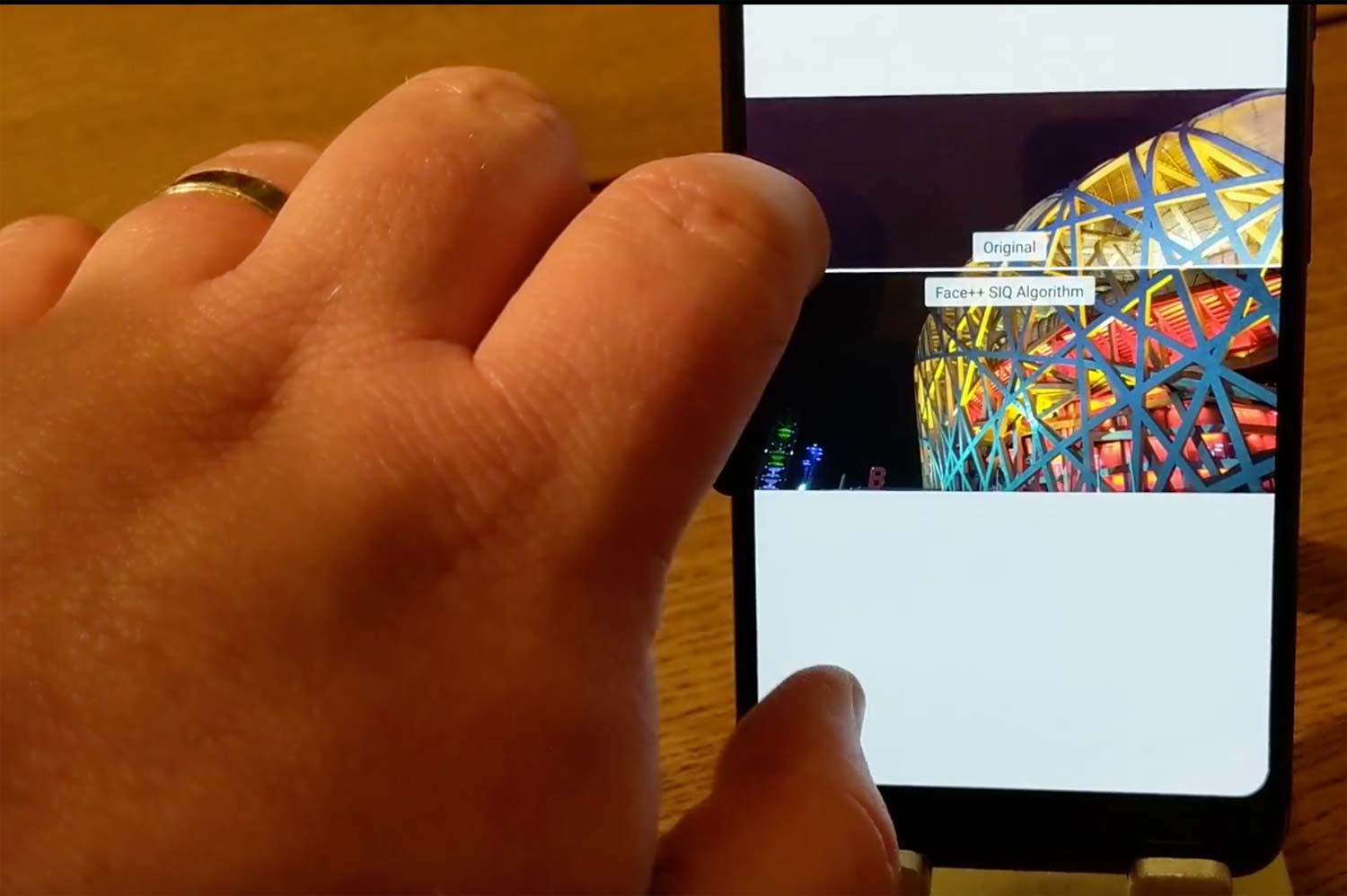
Qualcomm also says that the Spectra 380 supports video recording using HDR 10+, the first ISP that does so. That allows the camera on Snapdragon 855-powered devices to capture more than 1 billion shades of color without sacrificing contrast. Qualcomm says it's lined up a phone maker to bring HDR10+ support to the market in 2019.
The Snapdragon 855 is also adding hardware acceleration for the HEIF file format, an important addition given the number of phones with multiple cameras. All those shots captured by different sensors can be saved in a single HEIF file. As a result, Qualcomm promises a 50 percent reduction in file size for images.
But HEIF support is about more than just more compact file sizes, Heape said. HEIF is able to save video as well as multiple stills in a single file. It can also embed a lot of metadata, from time and location stamps to depth maps, which would allow you to go back later and create a portrait mode image. Qualcomm expects to take advantages of more of these types of HEIF-enabled features in future versions of its mobile processor.
Wi-Fi 6-ready
Souped-up cellular connectivity is only part of the story with the Snapdragon 855. The new mobile platform also features faster Wi-Fi connectivity.
To that end, Qualcomm says the latest Snapdragon platform Wi-Fi 6-ready, meaning it can work with the latest wireless standard — at least once router and networking equipment makers start cranking out Wi-Fi 6 devices. Snapdragon 855 also supports Qualcomm's 802.11ay-based 60 GHz Wi-Fi mobile platform, which is capable of delivering 10 Gbps speeds at latency equivalent to wired connections.
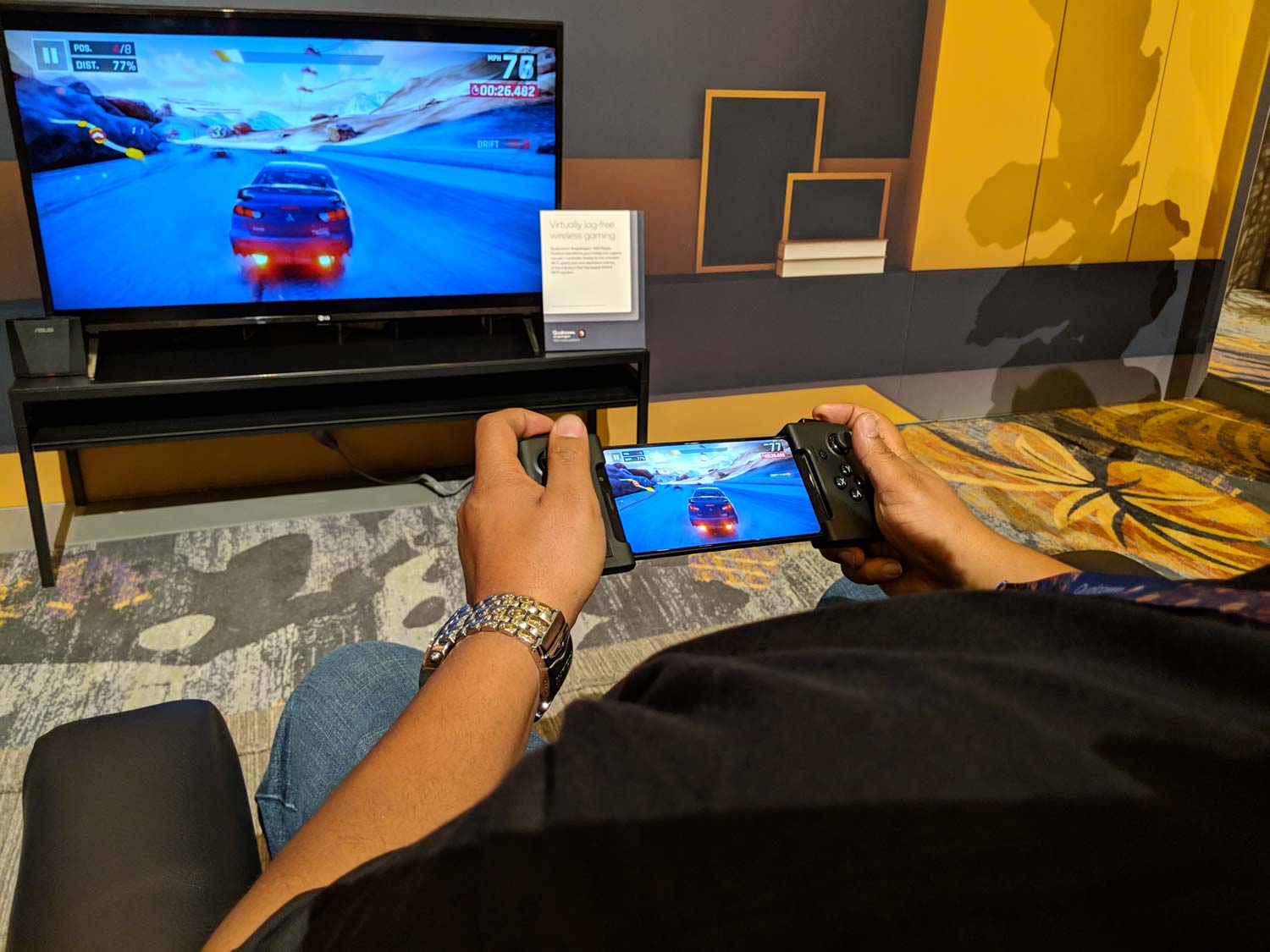
In a demo area, I played Asphalt 9 on a Snapdragon 855-powered mobile device with a joystick accessory attached, and the gaming streaming to a big-screen TV set nearby. Taps and button presses I made on the phone registered instantly on the TV with no lag in responsiveness, essentially allowing me to enjoy a console-style game from my mobile device.
Faster and Better AI: Your phone's getting smarter
Qualcomm's fourth-generation AI engine draws on improvements to the Kryo CPU, Adreno GPU and Hexagon digital signal processor, an approach Qualcomm is happy to contrast with other mobile processor that limit AI to a single processor. The changes to the Hexagon 690 are particularly important here, as the DSP has doubled the number of core vectors from the Snapdragon 845. A redesigned Hexagon Tensor Accelerator also helps the Snapdragon 855's AI engine deliver a 3x improvement over AI performance in the current Qualcomm chipset.
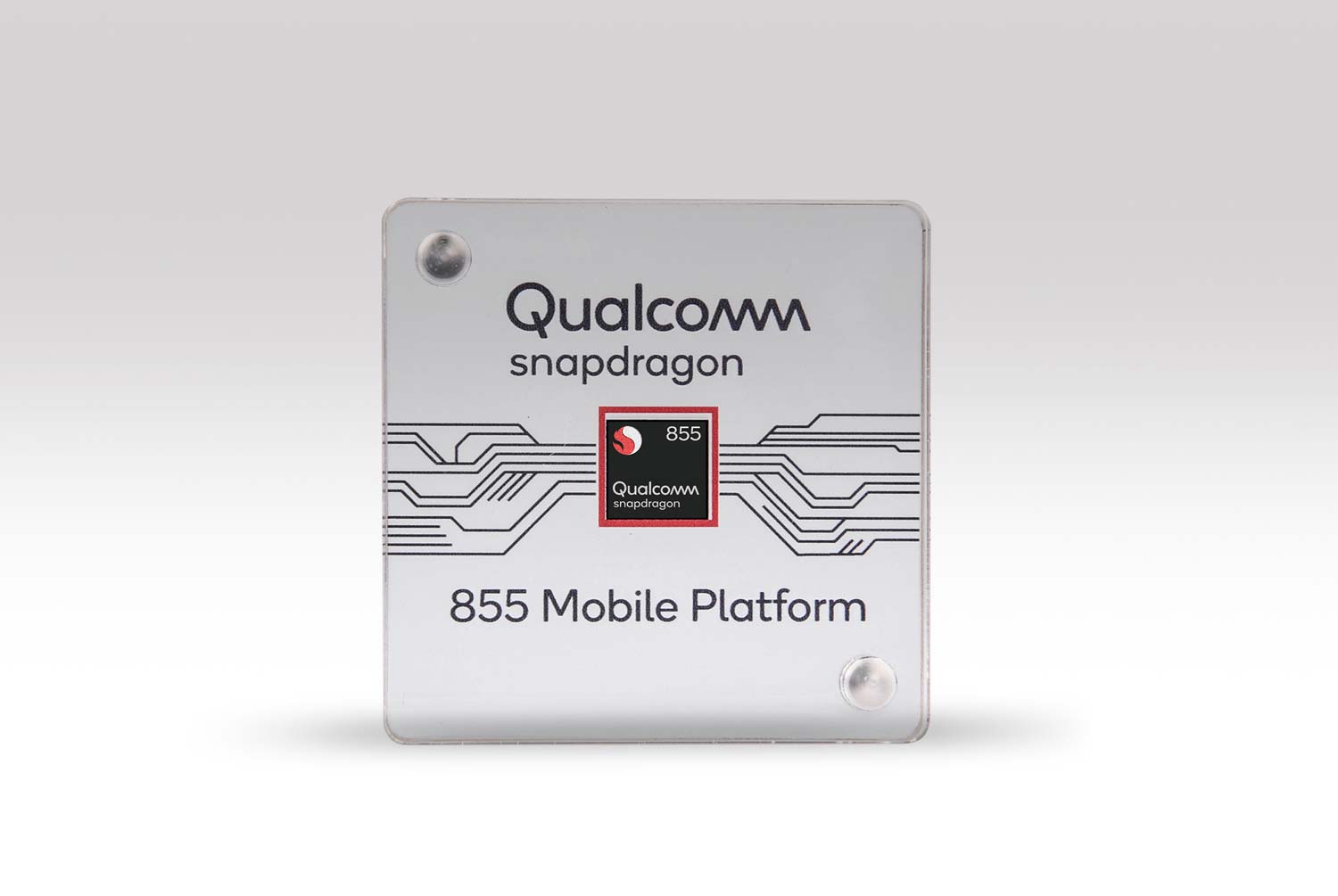
At the same time, hardware improvements to the 855's Adreno GPU boost the number of arithmetic logic units, while the Kryo 485 CPU also has introduced some changes to speed up AI performance. The bottom line: the Snapdragon 855 inside your future Android phone is going to be able to perform more calculations faster.
It's also going to be able provide better support for the multitude of voice assistants fighting for space on your smartphone. Features such as dedicated AI acceleration for echo cancellation and noise suppression should make it easier to talk to the assistant of your choosing on your smartphone and guarantee that your voice is heard.
Snapdragon Elite Gaming: Your next phone will be more entertaining
Mobile gamers figure to benefit from the Snapdragon 855, as Qualcomm is using this processor to introduce its Snapdragon Elite Gaming program. Qualcomm says it will offer true HDR gaming with cinematic color grading. It's also introducing new physical-based rendering that the company says will result in extremely realistic graphics and lighting.
Custom algorithms aim to reduce dropped frames by more than 90 percent, and support for both 5G and 60 GHz Wi-Fi are expected to reduce latency when you're taking on others in multiplayer games.
Movie Playback and Mixed Reality
As for movie playback, the Snapdragon 855 supports HDR10+, a first for mobile. An included Cinema Core decoder for H.265 and VP9 is up to 7x more power efficient, Qualcomm says, meaning you'll be able to watch more movies without having to search for a charging cable.
On the mixed reality front, the Snapdragon 855 supports 8K playback at 120 frames per second, which should deliver more immersive experiences in virtual reality. A demonstration by NextVR's David Cole brought that point home by illustrating how 5G can deliver that kind of clarity. An 60-frame-per-second broadcast of a soccer match in VR lacked the resolution of the 5G version that featured higher frame rates. You could recognize individual players and there was less blur around the ball as it was kicked toward the goal.
Main Image Credit: Qualcomm
Philip Michaels is a Managing Editor at Tom's Guide. He's been covering personal technology since 1999 and was in the building when Steve Jobs showed off the iPhone for the first time. He's been evaluating smartphones since that first iPhone debuted in 2007, and he's been following phone carriers and smartphone plans since 2015. He has strong opinions about Apple, the Oakland Athletics, old movies and proper butchery techniques. Follow him at @PhilipMichaels.

